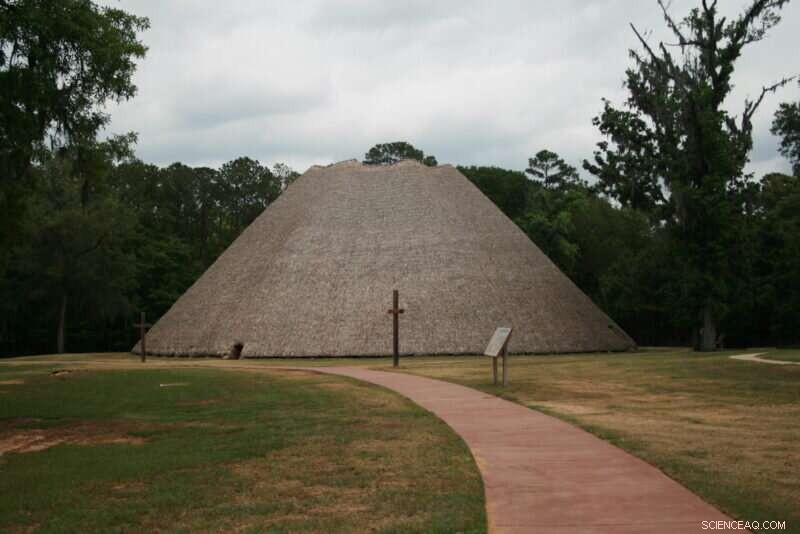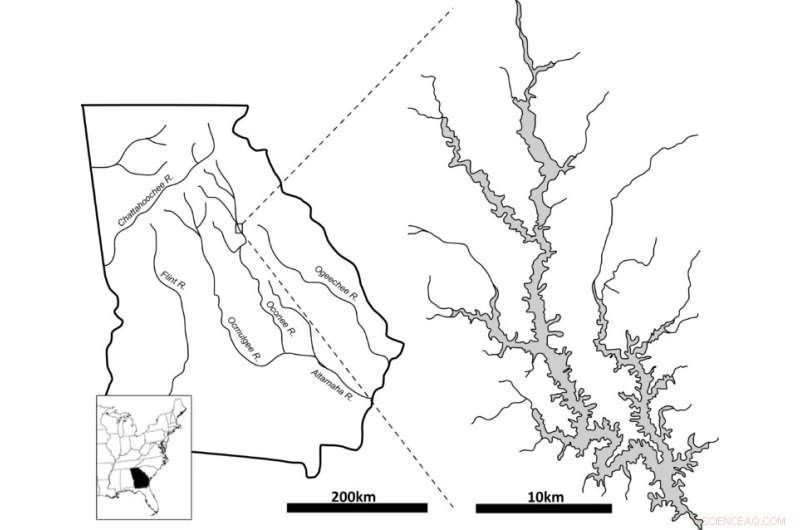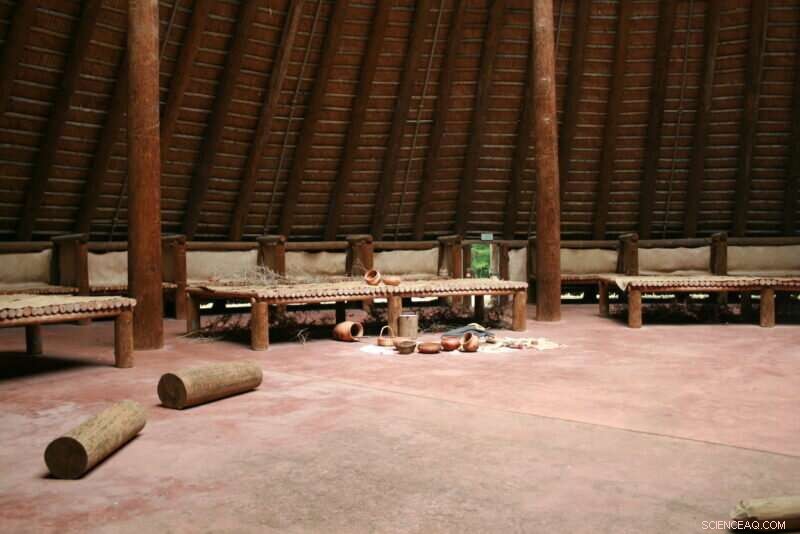Har demokratiet en separat oprindelse i Amerika?

Indfødte rådhuse (såsom dette rekonstruerede eksempel ved Mission San Luis de Apalachee i Tallahassee, Florida) var stedet for offentlige sammenkomster og ceremonier for tidlige amerikanske samfund, og beviser for dem er blevet placeret mange steder rundt om i sydøst. Kredit:UGA Laboratory of Archaeology
Det er almindeligt forstået, at demokrati er opstået i Middelhavsverdenen for omkring 2.500 år siden, før det spredte sig gennem kulturel kontakt til andre dele af kloden. Men ny forskning fra University of Georgia Laboratory of Archaeology, sammen med dets partnere i Muscogee Nation, indikerer, at indbyggerne i Amerika kan have praktiseret kollektiv regeringsførelse i demokratisk stil mindst et årtusinde før europæisk kontakt.
Ifølge et nyt papir offentliggjort i tidsskriftet American Antiquity , artefakter fra Cold Springs-stedet i det centrale Georgia indikerer tilstedeværelsen af et "rådhus" på stedet, som blev besat for omkring 1.500 år siden, ifølge radiocarbon-datering. Stadig i brug i dag af efterkommere af disse tidlige amerikanske samfund, rådhuse var store, cirkulære strukturer, der kunne rumme hundredvis, ja tusindvis af deltagere i ritualiserede sammenkomster, der involverede kollektiv beslutningstagning.
Iroquois Confederacy, en liga bestående af fem indfødte nationer, der bor i det, der skulle blive det nordøstlige USA, er blevet fremholdt som et eksempel på et tidligt amerikansk demokrati. Men nogle arkæologer daterer fremkomsten af Iroquois Confederacy så sent som i midten af det 15. århundrede, blot et par årtier før europæisk kontakt. Baseret på analysen af Cold Springs-materialerne foreslår UGA-teamet, at demokratiske institutioner forbundet med kollektiv styring opstod meget tidligere i tiden.
"Det vigtigste er, at den slags demokratiske institutioner var meget længe levede og eksisterede - måske i årtusinder - før Europas ankomst," sagde Victor Thompson, Distinguished Research Professor og direktør for Laboratory of Archaeology. "Det er et helt andet perspektiv på indfødt regeringsførelse i denne region, end de fleste arkæologer har."

Cold Springs-stedet, der ligger omkring 75 miles øst for Atlanta, var delvist nedsænket under det, der nu er Lake Oconee, da Oconee-floden blev opdæmmet i 1970'erne. Siden stedets udgravning for næsten 50 år siden var Cold Springs' artefakter blevet arkiveret i Laboratory of Archaeologys samlinger, indtil UGA-holdet genundersøgte dem med ny interesse og nye teknologier. Kredit:UGA Laboratory of Archaeology
Historisk set, sagde Thompson, har fortolkningen af rådhuse været bundet til fortolkningen af jordplatformshøje; koncentriske cirkler af stolpehuller, de afslørende arkæologiske beviser for rådhuse, er ofte blevet fundet nær eller på toppen af platformhøje. Over the centuries since European arrival, a consensus emerged that, up until about 1,000 years ago, mounds and houses were purely ceremonial in purpose and constructed by largely egalitarian peoples, but at one point they suddenly transformed into political structures dominated by the village "chief."
"[The predominant view holds that] prior to 1,000 A.D., platform mounds are communal and they're built by these societies that don't have chiefs or anything like that," Thompson said. "But as soon as 1,000 A.D. hits, everyone has a chief, and the chief lives on top of the platform. Very convenient. Our new work adds more depth to this perspective and sheds light on the fact that while different positions existed in these governmental structures it is vastly more complicated, and democratic, than the traditional models posed by archaeologists since the 1970s."
Indeed, ever since Spanish explorers reported the first eyewitness accounts, indigenous American cultures have been portrayed as chiefdoms, led by autocratic-style individuals imbued with significant power over their people. However, according to UGA's tribal partners, this view conflicts with the forms of collective governance they still practice today and which, tradition has taught them, long predate the arrival of Europeans.
"We still have a National Council in our council house, which meets within it and passes national laws—it's been this way for hundreds of generations," said Turner Hunt, preservation officer for Muscogee (Creek) Nation and a co-author on the paper. "[The idea of chiefdoms] is a nuisance, and it's a grand narrative that's been very hard to overcome."
Today the Cold Springs site lies partially submerged by Lake Oconee, a human-made reservoir about 75 miles east of Atlanta. The site was excavated in the early 1970s prior to completion of the dam on the Oconee River that created the lake. For their current research, Thompson and his colleagues reexamined artifacts from that dig that have been in the Laboratory of Archaeology's collections for nearly 50 years.

Also referred to as rotundas or townhouses depending on the region, council houses often had highly structured seating arrangements denoting rank and status, as well as painted histories of the community on their walls. Credit:UGA Laboratory of Archaeology
"That's the beauty of museum collections," Thompson said. "They've just been sitting there, and they can tell you so much. All it really takes is new ideas, new methods, to be able to go back and look at these collections again."
The researchers performed new radiocarbon dating on the existing physical artifacts—44 new dates in all, which make Cold Springs now one of the best-dated early mound sites in the Southeast. The testing placed primary occupation of the site between A.D. 500 and 700, with construction of the council house beginning sometime around 500 A.D. As Thompson and his colleagues sifted through artifacts and other evidence, they stayed in continual contact with their Muscogee partners in Oklahoma.
"We were meeting on Zoom and looking at pictures of post holes—tons of pictures of post holes," said RaeLynn Butler, manager of the Historic and Cultural Preservation Department for the Muscogee Nation. "Our major contributions were to digest the information and provide the traditional knowledge and perspectives as tribal people that helped bring to this research some much-needed context of our social organization and traditional forms of government."
At the end of the day, both Hunt and Butler said, they hope to emphasize that sites like Cold Springs are not removed from contemporary society in a way similar to Stonehenge or the pyramids of Egypt. They are not relics of long-dead cultures with only historical or archaeological relevance.
"This is a paper about Ancestral Muskogean institutions, but there is a living, active culture that is directly connected to it," Hunt said. "We believe our governments, our democratic institutions, have been practicing this way of life for thousands of years. We are connected to these people through the way we still conduct ourselves today."
 Varme artikler
Varme artikler
-
 Video:Hvordan får man et fossil ud af sten? OmhyggeligtKredit:CC0 Public Domain Fossiler er bare ikke fundet. De synliggøres af det nænsomme og professionelle arbejde fra de lærde, der arbejder med dem. I denne video, Karie Whitman viser den møjsomme
Video:Hvordan får man et fossil ud af sten? OmhyggeligtKredit:CC0 Public Domain Fossiler er bare ikke fundet. De synliggøres af det nænsomme og professionelle arbejde fra de lærde, der arbejder med dem. I denne video, Karie Whitman viser den møjsomme -
 Hvordan er NASA golfbolde forskellige?Hvordan ændrede NASA fordybningerne på golfbolde? Se flere sportsbilleder. Thomas Northcut/Lifesize/Thinkstock Den russiske kosmonaut Mikhail Tyurin afstod akavet sin omfangsrige rumdragt mod ydersid
Hvordan er NASA golfbolde forskellige?Hvordan ændrede NASA fordybningerne på golfbolde? Se flere sportsbilleder. Thomas Northcut/Lifesize/Thinkstock Den russiske kosmonaut Mikhail Tyurin afstod akavet sin omfangsrige rumdragt mod ydersid -
 Rige barndomsvenner øger den fremtidige indkomst, viser Facebook-dataMed lidt hjælp fra deres venner:Ny forskning ved hjælp af Facebook-data har vist, hvordan barndomsvenskaber kan påvirke fremtidig indkomst. En analyse af 21 milliarder Facebook-venskaber viser, at
Rige barndomsvenner øger den fremtidige indkomst, viser Facebook-dataMed lidt hjælp fra deres venner:Ny forskning ved hjælp af Facebook-data har vist, hvordan barndomsvenskaber kan påvirke fremtidig indkomst. En analyse af 21 milliarder Facebook-venskaber viser, at -
 Mindre klassestørrelser er ikke altid bedre for elever, viser multinational undersøgelseKredit:CC0 Public Domain En ny statistisk analyse af data fra en langtidsundersøgelse om undervisning i matematik og naturfag har fundet ud af, at mindre klassestørrelser ikke altid er forbundet m
Mindre klassestørrelser er ikke altid bedre for elever, viser multinational undersøgelseKredit:CC0 Public Domain En ny statistisk analyse af data fra en langtidsundersøgelse om undervisning i matematik og naturfag har fundet ud af, at mindre klassestørrelser ikke altid er forbundet m
- Besværet med raketter
- At bygge fremtiden, én robobåd ad gangen
- Hvad forudsiger bedst vold i Richmond-kvarterer? Uagtsomme udlejere
- Dawn observerer Ceres; tredje reaktionshjul funktionsfejl
- NASA-NOAA-satellitten fanger orkanen Nana, der går i land i ly af natten
- Oprydning i Stillehavet efter hjem sprængt i stykker af superstorm


